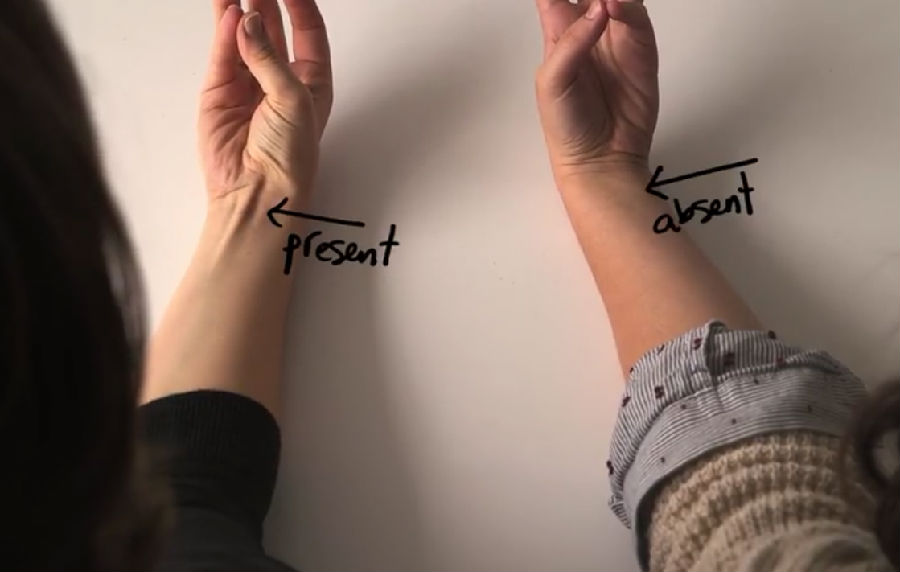(单词翻译:单击)
Your body is a temple,
你的身体不仅是一个神圣的殿堂(语出《圣经》)
but it’s also a museum of natural history.
它还是一座自然历史博物馆
Look closely and you’ll see parts that aren’t there because you need them
仔细观察,你会发现,你的身体有些部位之所以存在并不是因为你需要它们,
but because your animal ancestors did.
而是因为你的动物祖先需要它们
No longer serving their previous function
这些部位虽然已经不再发挥作用了
but not costly enough to have disappeared,
但是对我们并并没有太大影响,所以还不至于让它消失
These remnants of our deep history only make sense within the framework of evolution by natural selection.
遥远的历史在我们身上留下的这些印记,只有用物竞天择、适者生存的理论才能解释得通
With your arm on a flat surface,
把手臂放在一个平台上
push your thumb against your pinky and tip your hand slightly up.
用力让大拇指弯向小指,稍稍抬起手腕
If you see a raised band in the middle of the wrist,
如果你能看到手腕中间有一条凸起的筋
you’ve got a vestigial muscle in your forearm.
那就表示你的前臂里有一条遗迹肌
That tendon you see connects to the palmaris longus,
这条肌肉就是掌长肌
a muscle that around 10-15% of people are missing on one or both of their arms.
约有10%到15%的现代人有一只或者两只手没有了这块肌肉
It doesn’t make them any weaker though.
但那些人并不比我们柔弱
There’s no difference in grip strength.
他们的抓力也并不比我们小
In fact, it’s one of the first tendons that surgeons will take out
事实上,这块肌肉是外科医生
so they can use it in reconstructive and cosmetic surgeries.
在做皮肤修复手术或整容手术时首选的肌肉之一
You can find the palmaris longus across mammal species,
在任何一种哺乳动物身上,我们都能找到掌长肌
but it’s most developed among those that use their forelimbs to move around.
但掌长肌最发达的,要数靠前肢移动的哺乳动物
In primates, that means the muscle is longer in lemurs and monkeys
拿灵长类动物来说,这意味着狐猴和猴子的掌长肌
and shorter in chimps, gorillas and other apes that don’t do a lot of scrambling through trees.
要长于不经常在树间荡来荡去的黑猩猩、大猩猩等猿类
It’s not the only leftover muscle that we've got.
但掌长肌并不是我们身上唯一的遗迹肌
Look at the three that are attached to our outer ear.
我们不妨看看这三处与外耳相连的肌肉
We can’t get much movement out of these muscles,
这些肌肉活动的幅度非常有限
especially compared to some of our mammal relatives who use them to locate the sources of sounds.
比起我们那些用这些肌肉进行声源定位的近亲哺乳动物,这一点尤其明显
Presumably this would have been quite helpful for early nocturnal mammals.
据推测,这对早期的夜间活动的哺乳动物非常重要
In humans, you can still detect the remnants of this adaptation with electrodes.
但我们还是能够用电极检测到这种进化在我们身上残留的痕迹
In one study, researchers recorded a spike of activity in the ear muscle cells in response to a sudden sound.
研究人员实验发现,在突然受到声音的刺激时,受试者耳部肌肉细胞有活动的迹象
Not enough to move the ear, but detectable.
尽管还不足以活动耳朵,但还是能够检测得到
And you can probably guess the location of the sound based on the results
根据实验结果,你几乎还能够猜到声源的位置——
it came from a speaker to the left of the study subjects.
原来是位于受试者左边的扬声器发出的声音
So this is their left ear subconsciously trying (and failing) to pivot toward the sound.
这张图显示了受试者的左耳下意识地想要朝声源转动(但并未成功)
You can see another futile effort by our vestigial body parts when you get goosebumps.
鸡皮疙瘩是人体的另一个进化残留痕迹
When we’re cold, tiny muscles attached to our body hairs contract,
感到寒冷的时候,与汗毛相连的局部肌肉收缩
pulling the hair upright which causes the surrounding skin to form a bump.
汗毛就会竖起来,汗毛周围的皮肤也会跟着凸起
For our furry mammal relatives,
就我们那些毛茸茸的近亲哺乳动物而言
the raised hair increases the amount of space for insulation,
毛发竖立起来能够增加隔热的空间
helping them stay warm.
从而达到保暖的效果
Birds can do this too.
鸟类也是一样
you’ve probably seen a puffy pigeon on a cold day.
你应该看到过大冷天里毛茸茸的鸽子吧
Adrenaline is one of the hormones involved in the body’s response to cold temperatures,
肾上腺素是我们的身体应对寒冷时产生的激素之一
and it’s also part of the fight or flight response.
同时也是应对打斗和飞行的反应之一
So it helps some animals appear larger when they’re threatened.
肾上腺素能够帮助某些动物在受到威胁时看起来更强壮
And it may be why surprising and emotional turns in music can give some people goosebumps.
并且,它还可能是为什么有些人在听音乐时听到很出人意料的转折或是情绪转折时会起鸡皮疙瘩的原因
And then there’s our tail.
接下来是我们的尾巴
At the end of our spine are a set of fused vertebrae
我们的脊椎尾部有几节椎骨
some people have 3, some have 5.
有的人有三节,有的人有五节
We call it the tailbone.
我们称其为“尾骨”
It now serves as an anchor for some pelvic muscles
如今,尾骨的作用是控制部分盆骨肌肉的活动
but it’s also what’s left of our ancestors’ tails.
但它同样是我们祖先的尾巴在进化过程中留下来的
Every one of us actually had a tail at one point.
其实,每个人都曾有过尾巴
When the basic body plan is being laid out at around 4 weeks of gestation,
婴儿长到四周左右的时候,基本的身体结构就已经出来了
humans embryos closely resemble embryos of other vertebrates.
在这一点上,人类的胚胎和其他脊椎动物的胚胎极为相似
And that includes a tail with 10-12 developing vertebrae.
那个时候的胎儿已经长出了有10-12节椎骨的脊椎
In many other animals, it continues to develop into a proper tail.
就很多脊椎动物而言,那个脊椎会继续发育成一条合格的尾巴
But in humans and other apes,
但人类和其他猿类不同
the cells in the tail are programmed to die a few weeks after they appear.
脊椎的细胞注定要在几周之内死亡
Vary rarely though, a mutation allows the ancestral blueprint to prevail
尽管在极少数情况下,基因突变会让祖先留下的这一印记得逞
and a human baby will be born with a true vestigial tail.
使得婴儿出生时带着一条真正的椎尾
The most adorable vestigial behavior is the palmar grasp reflex,
最惹人喜爱的进化残留应该是手掌握持反射
where infants up until they’re about 6 months old
也即,婴儿在长到六个月大以前
have this incredible grasp on whatever you put in their hand.
会牢牢抓住你给它的任何东西
There’s a similar reflex for their feet.
他们的脚也有同样的反射现象
I wanted to show you this great piece of footage from the 1930s where they demonstrated this behavior.
二十世纪三十年代的一个影片很好地展示了它们的这一行为,大家不妨看一下
These babies are only 1 month old
这些宝宝才一个月大
and you can see that their inner monkey can support their entire weight.
它们体内的猴子习性使得他们能够整个吊起来


